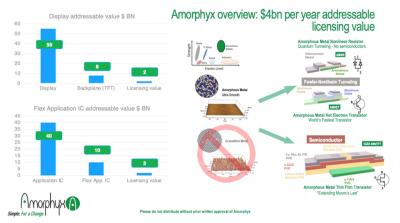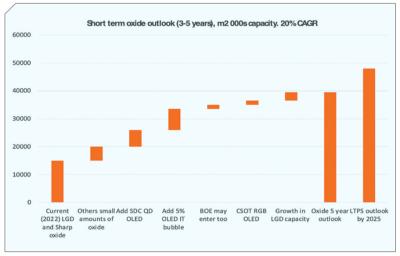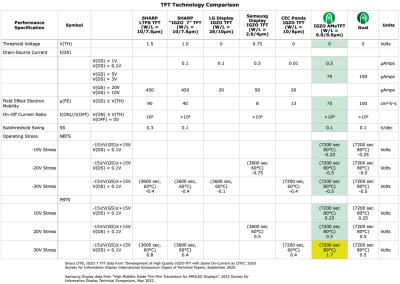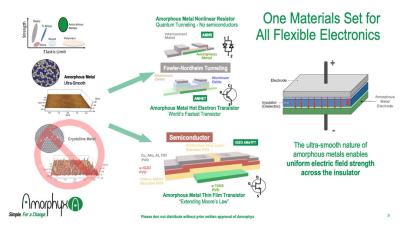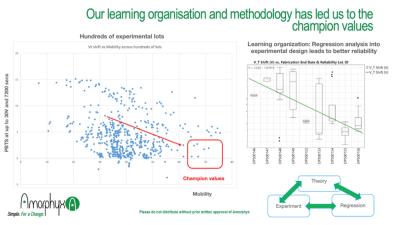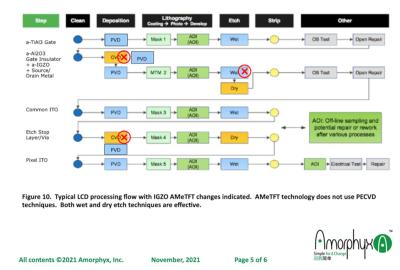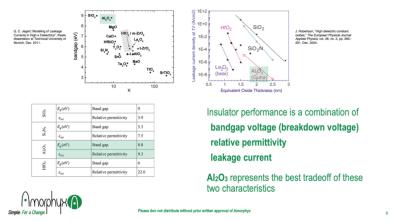This is a sponsored post by Amorphyx, where display industry consultant Ian Hendy has interviewed Amorphyx's CEO John Brewer
Q: Can you start by telling us a little about what Amorphyx does, John?
Amorphyx has several fundamentally new technology platforms that provide for TFT performance improvements in three areas: (1) Switching speeds, with options to move to the Tera-Hz range ultimately, (2) Power, where the IGZO AMeTFT can achieve even lower power performance than today’s LTPO OLED Pro Motion displays and better refresh range, and (3) Small transistor size.
Our technology platforms are lower cost than the alternatives, and move from amorphous and crystalline semiconductor approaches, to devices based on different effects that do not have a semiconductor at all, yet can still drive a display, drive current, deliver grey scale and switch very fast. Or they can operate a flex IC at higher clock speeds than known today.
For now, our main commercial focus is on IGZO AMeTFT which is fundamentally a potential replacement transistor for LTPS or LTPO used in modern OLED phones and has the capability to replace more highly compensated LTPO circuits in modern Smartphone displays due to enhanced stability.
Q: So why is all of this so big of a deal?
Here I want to make 2 major points. Firstly is that the role of high performance oxide in the display industry at the moment is increasing. So much so that it is beginning to catch up on LTPS as the second most used semiconductor approach. Recent announcements from SDC have been around expansion of FMM (Fine metal mask) processing techniques into large glass (Gen 8.7) to help grow the OLED franchise in tablets, and notebooks.
This expansion will be enabled by high performance oxide approaches not LTPS. So the importance of high performance oxide backplanes is increasing up to 40m m2 per year within a few years (Source: Hendy Consulting, Wiley).
The second point we can make then relies on the fact that our AMeTFTs do not just have higher mobility. They also have very low leakage currents and decent stability. Meaning we are just now looking at a 2T1C circuit made out of only our IGZO AMeTFT transistors and it has already shown a capability to do 0.06Hz refresh rate. Even LTPO that Samsung is using for Apple iPhone Pro Motion and Samsung Galaxy S displays can only do down to 48 Hz, so then we are already miles ahead here, giving the options of further power savings on the home screen for example in an OLED Smartphone display.
And we believe that our 2T1C circuit may have enough stability to need much less compensation than a typical LTPO circuit, massively reducing complexity and cost and allowing a path for new players other than Samsung to offer a refresh-rate capable, OLED display. So the addressable market for low power, high end OLED Smartphone displays (LTPO) is probably around $6bn as a single market opportunity. This is a large opportunity
Q: You have made some exciting oxide TFT performance progress this year, John. Perhaps you can explain the performance of your champion IGZO AMeTFT devices?
Well, our top performing IGZO TFT now has a field effect mobility of more than 70 cm2/Vs whilst at the same time meeting the requirements for less than 1V movement in the Vth under positive and negative bias stress at 20V for 7200 seconds. This sort of mobility is the sort of level typically found in mass production LTPS.
At 30V stress we can find a recipe that has a mobility of more than 40 cm2/Vs and we are not done yet; numbers are still going up. The 70 cm2/Vs is getting into the range of what the best mass production LTPS achieves today. We will leave our champion device performance numbers on our website at www.amorphyx.com in our Product technology guide publication, so that readers can follow our improvements, but for now these are the top specs:
Q: Can you explain how you get to those levels of transistor performance?
We get to these levels of performance through new insights about electric field strength and its role in enabling all of the semiconducting layer to transport electrons - known as operating the semiconductor in “bulk accumulation”. We have found that if we use a higher dielectric constant insulator and reduce the insulator thickness, then you drive up the capacitance of the TFT but you also drive up the transconductance of the device. But the transconductance increases faster than the capacitance.
The net result is an increase in mobility, since with the higher electric field strength then we are using the whole of the semiconductor to drive current. We use aluminium oxide as the insulator and we can have thin layers since we have a very smooth underlying bottom gate metal.
Q: Are you talking about TFT simulations or can you prove this assertion?
No, these are not simulation results, these are real devices that we build and test based on university level equipment in Corvallis, OR. We have now over 400 lots of experiments where we have varied layer thicknesses and process conditions and we have used regression analysis to drive the experimental agenda. We now have a theoretical model which we can match to the underlying TFT performance, so we can explain how we get to 70 cm2/Vs and we know we can go higher, now by taking the semiconductor layer thickness up.
Q: That sounds great but is there something unusual about your process or materials that would make it hard for a display player to adopt your approach?
No, we are an all-sputter process, with no novel steps other than one reactive sputter step which is a little unusual, but no real challenge. We are typically a 5-6 mask process with all known processes and materials. Some people claim that working with aluminium oxide could be more challenging for particles or etch reasons, but we have not found this to be the case.
Q: Do you need to move to aluminium oxide to make this work? Can you stick with a more customary SiN or SiO2 insulator?
It is the dielectric constant and the high breakdown strength of aluminium oxide that accounts for half of the gain in electric field strength so it is important. The other portion is that with an amorphous metal gate that is very smooth so that we can use a thinner gate insulator without the variations in insulator thickness that result from spikes in a crystallized metal's surface.
Q: Does the increase in electric field strength mean that the devices will fail or be less stable?
Our data and theoretical model tell us that operating metal oxide semiconductors in bulk accumulation using AMeTFT’s materials system means increasing electric field strength does not necessarily reduce device stability . Our reliability information is given above, and we can achieve 70 Vs/cm2 with the necessary <1V PBTIS and NBTIS reliability stats on university grade equipment and with no control of room conditions at 20V bias stress for 7200 seconds. For the 30V stress the mobility is currently lower but we are working on that
Q: So what feedback are you getting from the market?
There is a lot of interest in our work, we are being invited to speak at the major display technology conferences and we have executive level access at Tier 1 display manufacturers as well as the Tier 1 consumer electronics OEMs. But anything new and different from the status quo is understandably met with skepticism from industry. We are still spending quite a bit of time educating Chinese and Korean players about the mechanisms of AMeTFT. What we are saying about capacitance and field strength is new to the display industry, so we need to keep repeating our story and showing the results so that people begin to believe. We think our message is beginning to get across - evidenced by LG’s selection of Amorphyx for collaboraion in their NOVA Innovation program, announced at CES2023.
Q: So where does Amorphyx go from here?
A: Well we are beginning to work fairly soon with the LG Group, which will be announced at CES 2023, and from there we are pushing on the door of China to look at adopting our technology. We are starting on a relationship with one of the world’s top device physics research universities, so that we can get really high academic rigour in device physics theory to underpin our work. And this is on top of our relationships with Arizona State and Zhejiang university in China.
Our IGZO AMeTFT is beginning to get into the leadership pack of processes world-wide (along with Sharp and LGD), and remember we are working on university grade equipment. We expect an improvement on moving to mass production fabs. With all the investment now being planned for Gen 8 FMM OLED fabs (and SDC will be the first), we think the time is right for a re-evaluation of what can be achieved with high performance IGZO. Our 2T1C circuit is ripe to be a strategic replacement for more compensated circuits at the high end of the Smartphone market. In the market right now, the capacity for IGZO fabs is increasing so that it is beginning to clip on the heels of LTPS area. These are exciting times!
Thank you John for this great interview. For more information contact info@amorphyx.com or visit www.amorphyx.com
